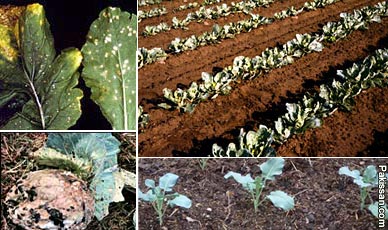|
Main Page
|
![]() |
Management of crops in frost
By Muhammad Amjad Ali and Dr Shahid Niaz
 SEVERE
winter weather conditions can create many problems for
crop plants jeopardising their health and even their
lives. The frost can significantly damage different
parts of the plants resulting in low agricultural
productivity. Various measures can be taken to tackle
this problem. SEVERE
winter weather conditions can create many problems for
crop plants jeopardising their health and even their
lives. The frost can significantly damage different
parts of the plants resulting in low agricultural
productivity. Various measures can be taken to tackle
this problem.
Frost occurs when temperature around the plant drops
below 0°C. At this temperature, water turns into ice
crystals on the surface of the plants. Frost can injure
active tissues that are insufficiently ‘hardened’ to
withstand the cold temperatures which may lead to
stunted growth and even death of plants. Flower buds,
vegetative buds, branches, stem, crowns, bark, roots, or
even the whole plant may be injured by frost.
Winter desiccation commonly called “winter drying” or
“winter burn, occurs due to intensity of frost spells.
During severely cold weather, the ground may freeze to a
depth beyond the extent of the root system, thereby
cutting off water supply to the plants. Injury due to
desiccation is commonly seen as discoloured, burned
leaves or whole plant. It is worst on the side facing
the wind thus causing extra damage. Frost prevents
plants from having firm contact with the soil and
exposes the roots to wind desiccation.
There are many variables that affect the actual critical
temperature for a given plant and the amount of frost
injury. These are duration of cold, growing conditions
prior to the cold event, cultivars: (because of plant
habit, or avoidance, rather than genetic differences),
stage of development, super cooling (in the absence of
ice nucleation points, plant sap can cool below the
freezing point without forming ice crystals), soil type
and condition (moist dark soil holds more heat than dry
light soil), incidence of freezing wind.
Soil moisture and compaction can have a significant
effect on temperature. A moist compact soil will store
more heat than a loose dry soil and therefore has more
heat to transfer to the crop at night. Cultivation just
before a frost can increase the risk of injury, because
the soil is looser and drier after cultivation. Soil
under a grassy cover crop will hold more heat if the
grass is mowed short.
Although it is difficult to manage frost occurrence in
various crops, different practices can be helpful in
this respect. Proper revised irrigation schedule can be
helpful to cope with low temperature injury. Irrigation
frequency should be increased in case of heavy frosts
with less amount of water per irrigation. This will
moisten the soil resulting in more uptake of water by
plants. This water will help the plant sap to move
efficiently from leaves to other plant parts. One
negative side effect of more frequent irrigation for
frost protection is increased potential for disease
outbreaks. Pathogens of many diseases grow rapidly in
moist and humid conditions.
Mulching is one of the most important ways to maintain
healthy plants under frosty temperature. Mulch is any
material applied to the soil surface for protection or
improvement of the area covered. Mulches keep the soil
cooler in the summer and warmer in the winter, thus
maintaining a more even soil temperature. In addition to
many advantages, mulch such as dried grass clippings,
hay or straw, leaves can be used temporarily to cover
tender plants to protect them from frost injury.
Another approach to modify the micro-climate to enhance
plant productivity by plastic material is the use of row
covers. Row covers may be used during the cold season to
conserve warmth, stimulate germination and early growth,
protect plants from frost injury, and improve the
quality of the crops. Row covers reduce evaporative
cooling and the rate of cooling under the cover.
Desiccation injury can be minimised by placing a
protective barrier and wind breaks over or around plants
to protect them from winter winds and sun will help to
reduce the incidence of this injury. Anti-desiccant
sprays applied once in late autumn and again in
mid-winter may also prove helpful.
Growing of crops under green house conditions might also
be effective to circumvent heavy frost. Plastic sheet
will conserve and retain the temperature trapped inside
the tunnel at the day time. This is due to the
accumulation of CO2 gas in the inner climate.
This concludes that frosty temperature causes serious
damage to crop plants, because it is a natural
phenomenon, it can not be wiped out but can be managed
through various means like proper irrigation, row
covers, mulching, protective barrier and wind breaks and
green house cultivation. All these practices are
economically diverse but have good impact on crop
productivity.
Courtesy: The DAWN |
|
Pakissan.com;
|
|
|